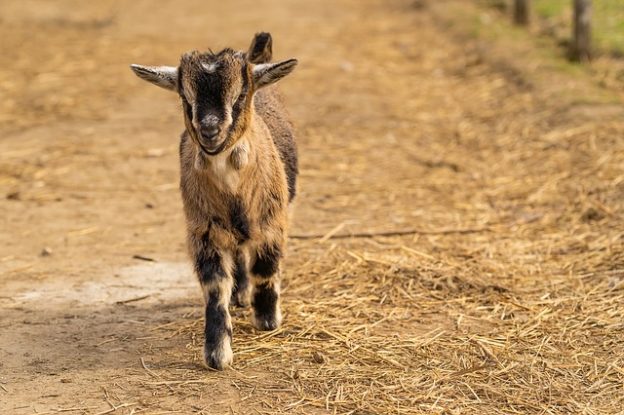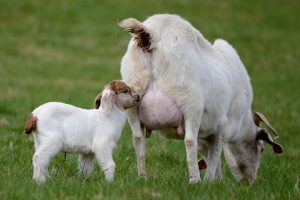Natural and artificial nursing of goats. Making ration and feeding schemes, the main rules and regulations.
Any goat owner should know how to feed newborn and older goats correctly. Animal health and longevity depend on nutrition, so farmers are very responsible when it comes to formulating the ration and choosing the way of feeding.
Ways of feeding the goats
There are two ways of feeding – with and without the mother. The first is suitable when the goat gives a small amount of milk. If the animal is very productive, the newborns are weaned and fed artificially. This is done in order not to lose the milk yield, because the goat gives much less milk while feeding the babies and during the recovery period after weaning.
When choosing the way of feeding one should not forget one rule – a goatling should receive a mother’s colostrum in the first hour of life. With it, newborns receive antibodies, which are essential for a weak immune system. Colostrum triggers the digestive system.
Feeding goats under the uterus
This is the easiest way of feeding. The newborns stay with their mother and suckle her milk themselves several times a day. This method produces healthy and productive animals.
Natural feeding is suitable for goats with low productivity. The cubs are left with the mother until 4 months of age. After 3 weeks, the calf’s ration is supplemented. This includes bone meal (6-7 grams), salt (5 grams) and some chalk. As they grow up, the amount of supplements increases. Older goats are given concentrated feed.
The main advantages of rearing with the mother:
- Babies rarely get sick;
- develop well;
- They gain weight quickly;
- The milk, which the calf receives directly from the mother, contains more nutrients.
How to feed a motherless goat
When motherless nursing, the newborns are taken away immediately after birth. You should not let the goats near the mother and then take them away, this will make the animal anxious. Feed the babies from a bottle with a teat, often using bowls. Milk is heated to a temperature of +38 degrees.
During the first few days, the goat gives colostrum instead of milk. It is sure to be collected in a clean container and given to the newborn. The first jets are not fed, as they contain many germs.
Approximate feeding regimen for motherless goats:
- For the first few weeks, the babies eat 5-6 times a day every 3-4 hours. During this period, milk is the basis of nutrition.
- Twenty days after birth, the goats are switched to two meals a day, but usually they are fed three times a day.
- Until 10 days, the cubs are fed on milk alone.
- On the 11th day, additional food is introduced, starting at 20 grams and up to 200 grams.
For feeding choose only enameled crockery.
Feeding ration for newborn goats
In the first days after birth, newborns are fed up to 6 times a day with an interval of 4 hours. Feeding begins with 100 grams of milk. As the foetus grows, the amount is increased and the number of feedings reduced. At three weeks of age, the cub eats about 1.2 liters of milk.
When the goats reach 40 days of age, the milk ration is reduced, replacing it with succulent, coarse and concentrated feed. Hay is introduced into the diet 2 weeks after birth. Animals are fed daily with warm water.
Concentrated, succulent and coarse fodder in goat nutrition
Concentrated feed is introduced into the diet when the babies are 3 weeks old. This includes a mixture of bran, split cake and oats. Gradually bone meal or chalk (up to 10 grams per day) is added to the feed.
Oatmeal must be included in the diet of older goats. Boil the porridge before feeding, add a little salt, cool down and strain. Include finely chopped vegetables and root vegetables in the diet. New types of food should be introduced over several days to avoid upsetting the digestive system.
One month after birth, the goats are released into the pasture with the adult animals. By this age, the babies do not recognize their mothers, so there are no problems with walking together.
Scheme of correct feeding of goats
During the first weeks after birth, the animals are given milk 4-5 times a day. The first feeding is at 5-6 in the morning and the last at 8-9 in the evening. At a time just born, a goatling drinks 200 grams of milk. Every day the rate increases and after a week reaches 300 grams.
At the age of three weeks, oatmeal is introduced into the ration, starting at 200 grams. Porridge replaces one milk feeding at first, and then gradually increase the volume and replace the other feedings. By one month of age give 300 grams of oatmeal at a time, when the goat reaches 60-65 days – up to 800 grams.
Concentrates are added to the diet of one-month-old calves, starting with 30 grams per feeding. Every week the amount of concentrates is doubled and by 3 months of age the goat eats 200 grams.
Root vegetables are first chopped into minced meat and then cut into small pieces before feeding. They are added to the food when the goats are 1 month old. They start with a volume of 40 grams, after 10 days the baby eats 60 grams, and by 3-4 months – 250 grams.
Approximate scheme of artificial nursing of goats
- For the first week, the animals are fed 6 times with 80 grams of milk.
- By the 11th day the number of feedings is reduced to 4, one meal is given, grams: 300 grams of milk and 200 grams of oatmeal.
- After three weeks, feed (grams) 300 grams of milk, 300 grams of porridge, 30 grams of concentrates and 40 grams of root vegetables at a time.
- At one month of age, the goats are transferred to three meals a day. At one meal they are given, grams: 350 milk, 500 porridge, 50 concentrates and 50 root vegetables.
- After 40 days, the amount of milk is reduced by adding porridge and root vegetables. Feed 250 g milk, 700 g oatmeal, 100 g concentrates and 60 g root vegetables at a time.
- At 2 months of age, the goat is given (in grams): 150 grams of milk, 800 grams of porridge, 150 grams of concentrates and 100 grams of root vegetables.
- At 3 months of age porridge is removed from the diet, with 100 g of milk, 300 g of concentrates and 250 g of root crops per meal.
Don’t forget that hay and grass should be in the feeders at all times, and water should always be readily available.
How to train a baby goat to eat from a bowl or pot?
Most farmers prefer to feed their cubs from enameled dishes (pots, bowls). This method is more convenient than bottle feeding because it is easier to disinfect and clean.
Here are the main rules for accustoming and feeding goats from a bucket or pot:
- The milk is heated to the right temperature (37-39 degrees);
all utensils must be very clean; - bowls are used for feeding at first, but in time they should be replaced by deeper bowls;
- the goat’s muzzle is dipped in milk, after which it begins to drink on its own;
- make sure the animals do not put their feet in the pot.
reference:


